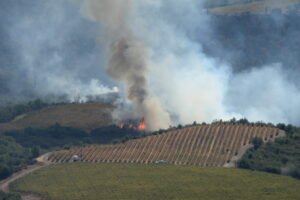Aleta George
On a late autumn afternoon, Mount Diablo is one of the places you might find male tarantulas out gallivanting. Given that they’ve spent about seven years living alone in underground burrows, one can hardly blame them for leaving home in search of females. Once they find one to mate with, they look for another, and then another. On and on it goes until they die of starvation, never to return to their burrows. And they’re surprisingly ill-equipped for life in the open: “With their poor eyesight and conspicuous presence, they have a hard time sneaking up on anything when outside the burrow,” says naturalist Ken Lavin, outings and volunteer coordinator for Greenbelt Alliance.
One way to learn about tarantulas firsthand is to join Lavin on his popular Tarantula Trek at Mount Diablo State Park. On last September’s trek, after a general introduction to tarantulas, Lavin pulled out Mia, his pet tarantula. Even the kids wanted to hold her and feel her legs tapping on their skin as she walked up their arms. Tarantula bites can kill, says Lavin, but only if you’re the size of a cricket. Their venom can paralyze and digest prey, but for a human, it’s about as painful and dangerous as a bee sting. The spider’s posturing is pretty intimidating, though. When threatened, it rears up on its hind legs and shoots abdominal spikes like a horror movie monster. (Although they look scary, tarantulas have more reason to worry about us tarantula seekers — if they’re dropped, their legs break easily, so don’t pick up wild spiders.)
We walked up the canyon and found several burrows with openings about the size of a nickel. One clue that you’re seeing a tarantula burrow is the discarded insect carcasses littering the entrance. Tarantulas line their burrows with silk that vibrates when prey is nearby. They also weave a thin veil of silk over the top to keep the burrow moist during the heat of day. A female will sometimes construct a veil across the top if she’s not open to suitors. “It’s the spider version of ‘not tonight dear,'” says Lavin. In winter they seal their burrows with dirt, and their slow metabolism allows them to go months without eating.
On our trek we saw five male tarantulas. Lavin says that in addition to seeing them at Mount Diablo, you can find tarantulas on the west- and south-facing slopes at Sunol Regional Wilderness, Del Valle Regional Park, Black Diamond Mines Regional Preserve, and Henry W. Coe State Park. At Coe, the Pine Ridge Association hosts a Tarantula Fest and Barbecue each fall. (Tarantulas are celebrated here and are definitely not on the menu.) This year’s event is on October 2, 2010. It sells out early, so get your tickets in advance at coepark.org. For interpretive events at Mount Diablo, go to mdia.org.
###
http://baynature.org/articles/jul-sep-2010/ear-to-the-ground/tarantula-trekking




